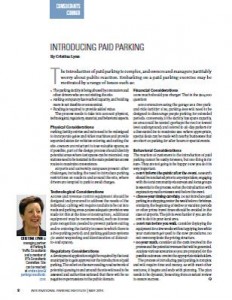The introduction of paid parking is complex, and owners and managers justifiably worry about public reaction. Embarking on a paid parking exercise may be motivated by a range of issues such as:
The parking facility is being abused by commuters and other drivers who are not visiting the site.
Parking occupancy has reached capacity, and building more is not feasible or economical.
Funding is required to provide added value.
The process needs to take into account physical, technological, regulatory, financial, and behavioral aspects.
Physical Considerations
Parking facility entries and exits need to be redesigned to incorporate gates and ticket machines and provide separated aisles for vehicles entering and exiting the site. Owners are reluctant to lose valuable spaces, so if possible, part of the design process should identify potential areas where lost spaces can be relocated. Pay stations need to be installed in the main pedestrian access routes to maximize convenience.
Airports and university campuses present other challenges, including the need to introduce parking restrictions on roads in and around the site, where drivers are tempted to park to avoid charges.
Technological Considerations
Access and revenue control equipment should be designed and procured to address the needs of the individual. Cabling will require conduits to be cut into roads and parking areas (unless adequate provision was made for this at the time of construction). Additional equipment may be recommended, such as license plate recognition (needed to prevent parkers exiting and re-entering the facility in cases in which there is a free parking period) and parking guidance systems (to assist wayfinding and identification of difficult-to-find spaces).
Regulatory Considerations
A development application might be required by the local municipality to gain approval for the introduction of paid parking. The effect on the surrounding road network of potential queuing in and around the site will need to be assessed and authorities satisfied that there will be no negative repercussions in the public domain.
Financial Considerations
How much should you charge? That is the $64,000 question!
Are commuters using the garage as a free park-and-ride facility? If so, parking fees will need to be designed to discourage people parking for extended periods. Conversely, if the facility has spare capacity, an area could be nested (perhaps the roof or lowest level underground) and offered to all-day parkers for a discounted fee to maximize use. Where appropriate, special deals can be made with nearby businesses that are short on parking for after-hours or special events.
Behavioral Considerations
The reaction of customers to the introduction of paid parking cannot be easily foreseen, but one thing is for sure: They are not going to be happy! How you do it is very important:
- Don’t inform the public after the event. Research should be conducted prior to any steps taken; engaging with the local community via surveys and focus groups is essential to the process. Soften the introduction with explanatory media releases well before the event.
- Choose your timing carefully. Do not introduce paid parking in a shopping center the week before Christmas. Similarly, the beginning of festive or vacation periods or other prime travel times should be avoided in the case of airports. The job is even harder if you are the first to do it in your local area.
- Don’t run before you walk. Consider deploying the equipment for a few weeks without applying fees while your customers get used to the new procedures. Do not overcomplicate the pricing structure.
- Do your math. Consider all the costs involved in the process and the potential revenues that will be generated. Analyze various scenarios so you are prepared for the possible outcomes. Involve the appropriate stakeholders.
The process of introducing paid parking is complex and will require time and money. As with most other ventures, it begins and ends with planning. The plan needs to be dynamic, benefiting from constant review to ensure success.
Cristina Lynn is managing partner of Parking & Traffic Consultants and a member of IPI’s Consultants Committee. She can be reached at cristina.lynn@parkingconsultants.com.
TPP-2014-05-INTRODUCING PAID PARKING

